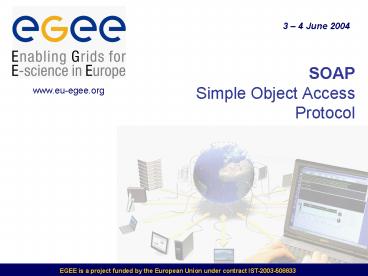SOAP Simple Object Access Protocol - PowerPoint PPT Presentation
1 / 20
Title:
SOAP Simple Object Access Protocol
Description:
SOAP is mechanism (protocol) for transferring information (messages) between ... SOAP says nothing about the content of the message the sender and the receiver ... – PowerPoint PPT presentation
Number of Views:85
Avg rating:3.0/5.0
Title: SOAP Simple Object Access Protocol
1
SOAPSimple Object Access Protocol
3 4 June 2004
www.eu-egee.org
EGEE is a project funded by the European Union
under contract IST-2003-508833
2
Objectives
- Understand the use of SOAP messages
- Become familiar with the syntax of SOAP
- SOAP in the context of Web Services
3
SOAP messages
- SOAP provides a standard envelope within which
a message can be delivered. - SOAP is mechanism (protocol) for transferring
information (messages) between applications which
may be widely distributed. - SOAP says nothing about the content of the
message the sender and the receiver must
understand the message for themselves. - SOAP is part of a communication stack.
4
Web services stack
Application
Application (servlet)
rpcrouter
Web server
SOAP
SOAP
HTTP
HTTP
TCP/IP
TCP/IP
Infrastructure (Data link)
Infrastructure (Data link)
5
Business mail analogy
- The SOAP envelope is analogous to a business
letter with an address within a distant
organisation. This gives the information needed
to get it from the senders building to the
recipients building. - The transport protocol is analogous to the
carrier used for transport between buildings.
(eg. FedEx.) - The web server and container act like the local
services for the recipient which place the
message in his/her pigeon-hole.
6
SOAP Structure(1)
- Each SOAP message will have
- An Envelope
- A Header (optional)
- A Body
- The Body may contain a Fault element
7
SOAP Structure(2)
- The envelope wraps the entire soap document
- The header contains allows additional information
to be passed as well as the body of the document
e.g. authentication - The body element contains the core of the SOAP
document this will contain either the RPC call
or the XML message itself - The fault information will contain any exception
information
8
Anatomy of a SOAP message
- lt?xml version1.0 encodingUTF-8?gt
ltSOAP-ENVEnvelope xmlnsSOAP_ENVhttp//schemas.
xmlsoap.org/soap/envelope/ xmlnsxsihttp//www
.w3c.org/1999/XMLSchema-instance xmlnsxsdhttp
//www.w3c.org/1999/XMLSchemagt lt/SOAP
-ENVEnvelopegt
ltSOAP-ENVHeadergt lt/SOAP-ENVHeader
ltSOAP_ENVBodygt lt/SOAP-ENVBodygt
9
SOAP protocol binding
- SOAPAction urnsoaphttpclient-action-uri
- Host localhost
- Content-Type text/xml charsetutf-8
- Content-Length 701
ltSOAP-ENVEnvelope xmlnsSOAP_ENVhttp//schemas.
xmlsoap.org/soap/envelope/ xmlnsxsihttp//www
.w3c.org/1999/XMLSchema-instance xmlnsxsdhttp
//www.w3c.org/1999/XMLSchemagt lt/SOAP-ENVEnv
elopegt
10
SOAP RPC
- SOAP RPC messages contain XML that represents a
method call or method response - The SOAP XML will be converted into a method call
on the server and the response will be encoded
into SOAP XML to be returned to the client
11
SOAP Faults
- SOAP errors are handled using a specialised
envelope known as a Fault Envelope - A SOAP Fault is a special element which must
appear as an immediate child of the body element - ltfaultcodegt and ltfaultstringgt are required.
12
A SOAP fault
- lt?xml version1.0 encodingUTF-8?gt
- ltSOAP-ENVEnvelope xmlnsSOAP_ENVhttp//schemas.
xmlsoap.org/soap/envelope/ - xmlnsxsihttp//www.w3c.org/1999/XMLSchema-inst
ance - xmlnsxsdhttp//www.w3c.org/1999/XMLSchemagt
- ltSOAP_ENVBodygt
- lt/SOAP-ENVBodygt
- lt/SOAP-ENVEnvelopegt
ltSOAP-ENVFaultgt ltfaultcodegtSOAP-ENVServerlt/
faultcodegt ltfaultstringgtTest
faultlt/faultstringgt ltfaultactorgt/soap/servlet/r
pcrouterlt/faultactorgt ltdetailgt .. lt/deta
ilgt lt/SOAP-ENVFaultgt
13
mustUnderstand attribute
- The mustUnderstand attribute can be placed in any
top level header element. - The presence of this attribute with a value of 1
or true means that the SOAP processor must
recognise this element. - If it does not recognise it, a fault must be
generated.
14
mustUnderstand example
- lt?xml version1.0 encodingUTF-8?gt
- ltSOAP-ENVEnvelope xmlnsSOAP_ENVhttp//schemas.
xmlsoap.org/soap/envelope/ - xmlnsxsihttp//www.w3c.org/1999/XMLSchema-inst
ance - xmlnsxsdhttp//www.w3c.org/1999/XMLSchemagt
- ltSOAP_ENVBodygt
- lt/SOAP-ENVBodygt
- lt/SOAP-ENVEnvelopegt
ltSOAP-ENVHeadergt ltjawsMessageHeader
xmlnsjawshttp//... SOAP-ENVmustUnderstand
1gt lt/jawsMessageHeadergt ltSOAP-ENVHeadergt
15
SOAP Attachment
Transport protocol
- Large quantities or binary data may not fit well
into a XML SOAP message. - In which case it can be sent out of band by
attaching it to a SOAP message - Analogy email attachments.
MIME header
SOAP ENVELOPE
SOAP HEADER
SOAP BODY
FAULT
Attachment
16
Attaching a file to a SOAP message
- To add a file to a SOAP message a tag is added
within the body of the message.
lt?xml version1.0 encodingUTF-8?gt ltSOAP-ENVE
nvelope xmlnsSOAP_ENVhttp//schemas.xmlsoap.org
/soap/envelope/ xmlnsxsihttp//www.w3c.org/19
99/XMLSchema-instance xmlnsxsdhttp//www.w3c.
org/1999/XMLSchemagt ltSOAP_ENVBodygt ltattachm
ent hrefURL/gt lt/SOAP-ENVBodygt lt/SOAP-ENV
Envelopegt
17
Deployment Making the container aware of a
servlet
- The web server has to be aware of the interface
and exposed methods of a servlet in order to use
it. - Using Tomcat as an example this can be done in a
number of ways.
1. We will entry the values manually into the
SOAP admin page from a Deployment descriptor in
the practical.
2. You can use the SOAP manager application from
the command line
3. You can manually edit Tomcats
WEB-INFO/web.xml file
4. You can create a WAR file and place it in
Tomcats webapps folder
5. You can use ANT
18
Using a WAR file
- A WAR file is basically an archive description of
a servlet installation - (JAR and WAR naming derives from UNIX TAR java
archive, web archive, tape archive). - Example placed in Tomcats webapps folder it can
be interpreted by the container.
19
Deployment Descriptor
A SOAP manager file
- ltisdservice xmlnsisdhttp//xml.apache.org/xml-
soap/deployment idurnstock-onhandgt - ltisdprovider typejava scopeApplication
methodsgetQtygt - ltisdjava classStockQuantity/gt
- lt/isdprovidergt
- ltisdfaultListenergtorg.apache.soap.sever.DOMFault
Listenerlt/isdfaultListenergt - lt/isdservicegt
Some containers (Tomcat) provide GUIs for
deployment
20
SOAP Implementations
- There are several implementations of the SOAP
Specification - Apache Axis
- GLUE
- Most J2EE application servers contain a SOAP
implementation - .NET has a SOAP implementation































